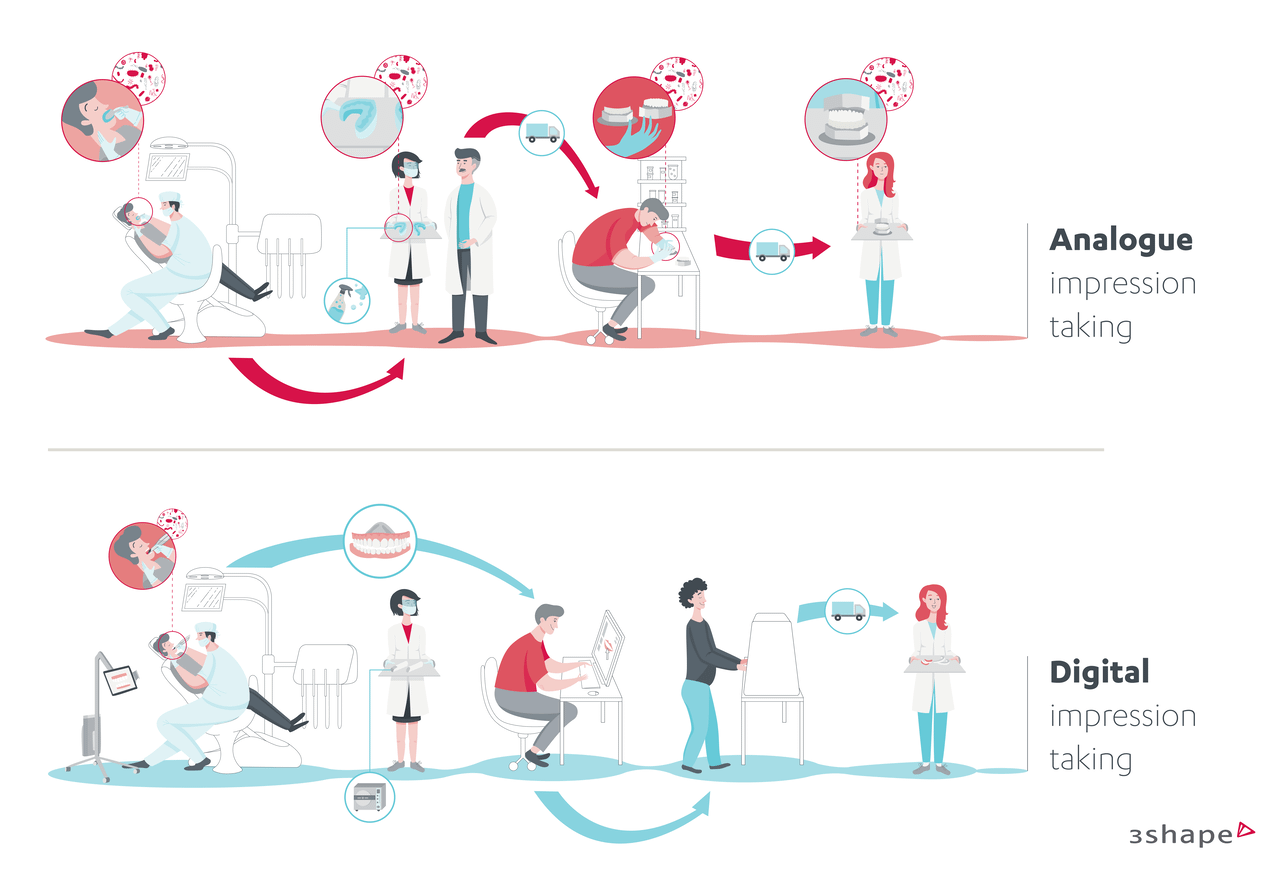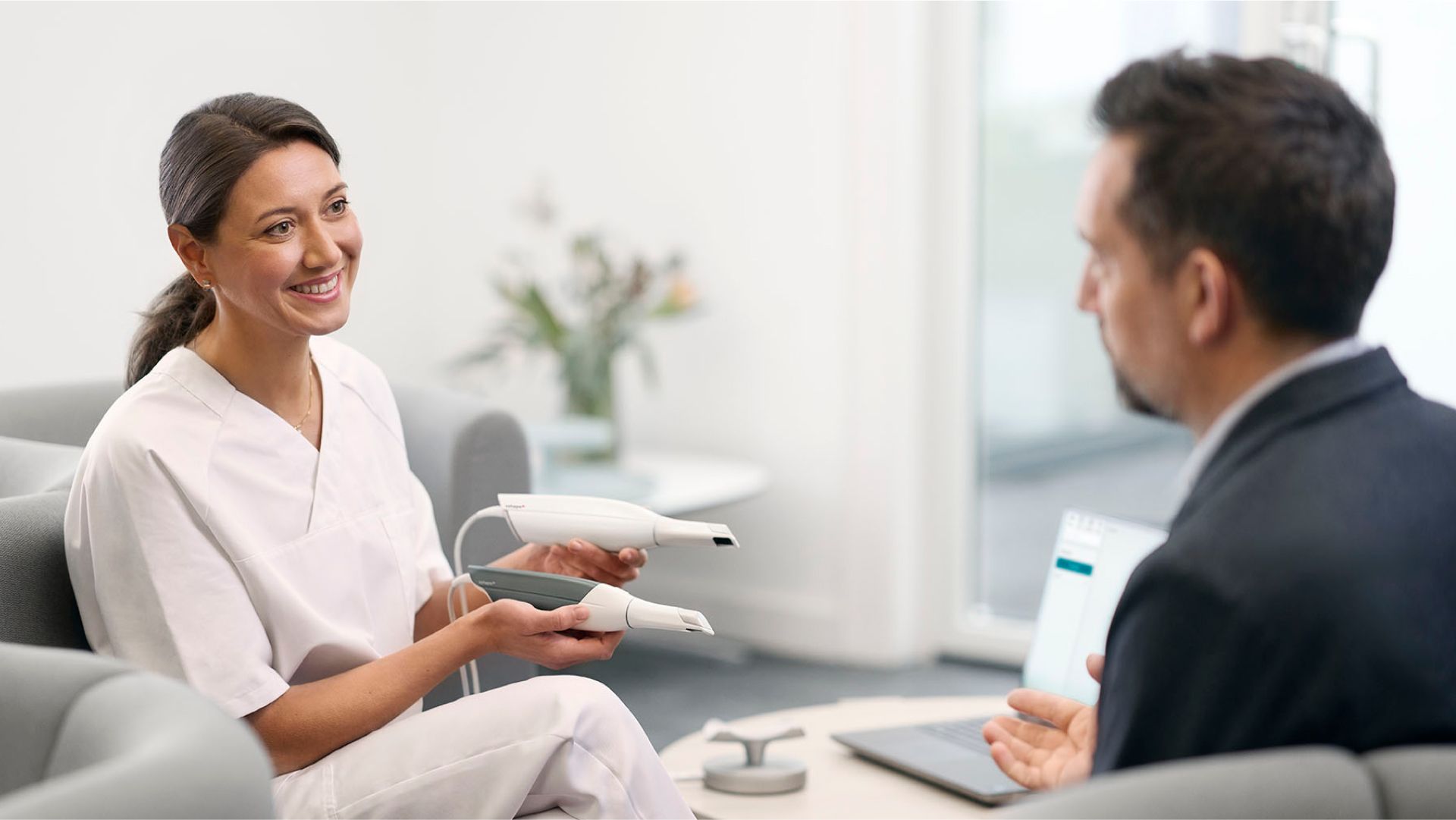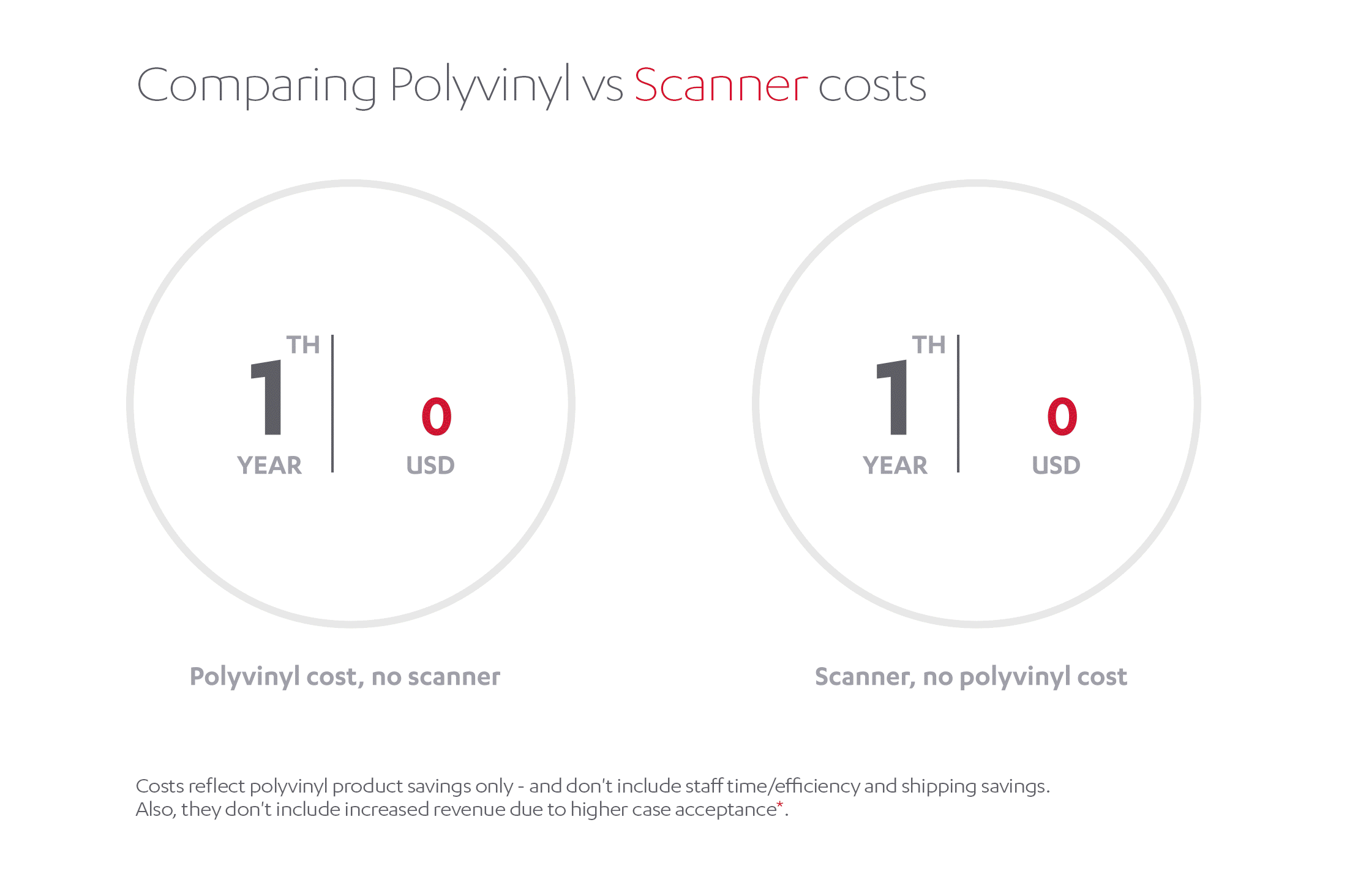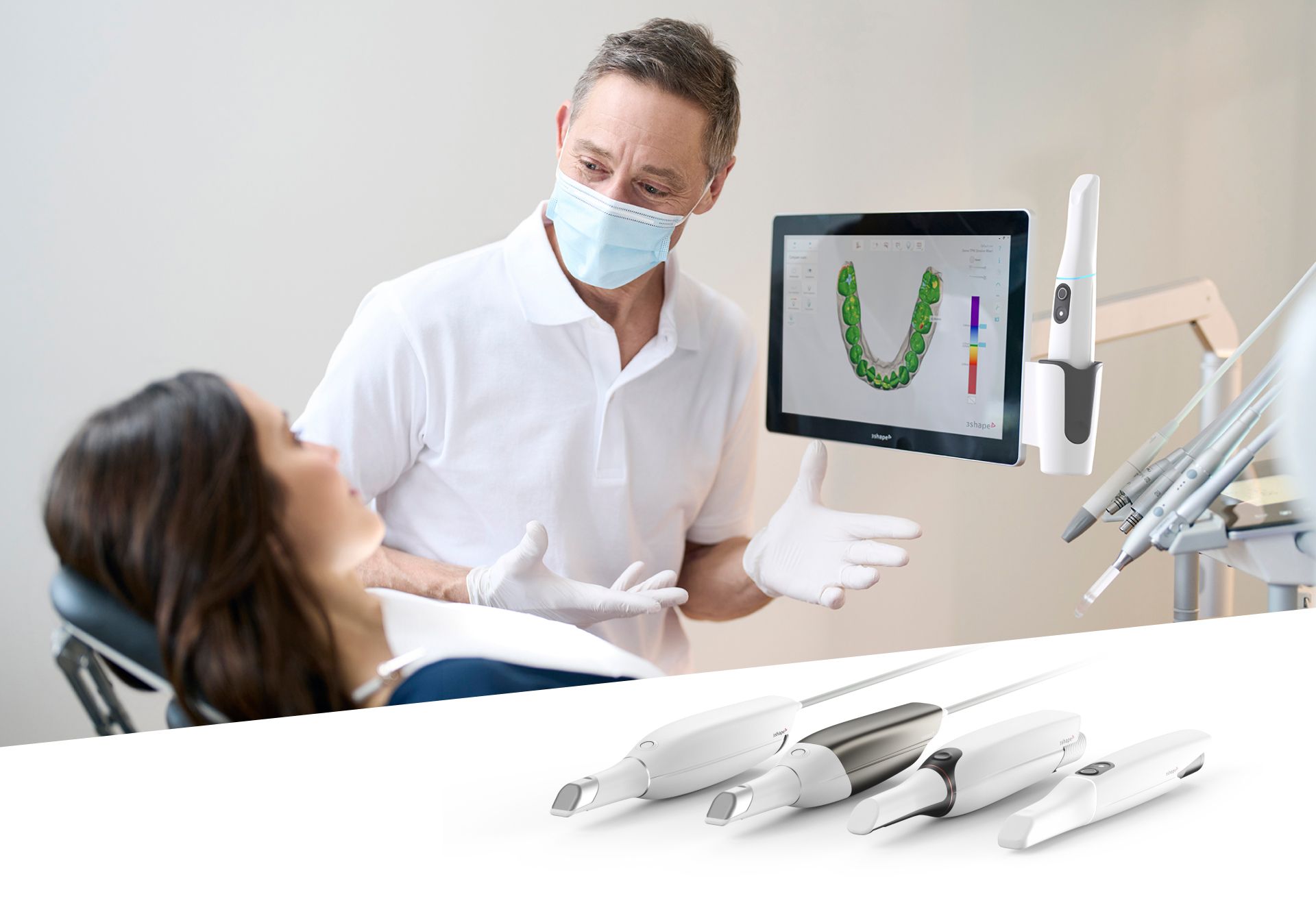- Home
- Blog
- Digital dentistry
- Intraoral scanners
Why an intraoral scanner is must-have equipment for your clinic
Dental 3D scanners are the future – they are also the present that patients are asking for.
An intraoral scanner for digital impressions is a must-have device to optimize clinic workflows and improve the patient experience. Right now, embracing intraoral 3D scanning can advance your work, make it easier, and elevate even further your hygiene practices.
Dental digital scanners are transforming modern dentistry – with the most technologically advanced models bringing a better patient experience, delivering higher standards of in-clinic hygiene, and making workflows quicker and easier for dentists.
But what is a digital intraoral scanner? What are intraoral scanner uses? And how exactly can a dental 3D scanner benefit your clinic?
What is an intraoral scanner?
Intraoral scanners, or digital scanners in dentistry, are tools that give dental practitioners a digital alternative to the traditional method of taking an analog impression.
There are various brands and types of dental scanners and even though they differ in some of their features, what they have in common is that they eliminate the need for both analog impressions and wax-ups, as well as the conventional hands-on fabrication processes associated with all-ceramic restorations.The result? The 3D teeth scan leads to accurate 3D images – sometimes in just seconds – and because of the quick lab turnaround times that they promote, intraoral scanners are now becoming the tool of choice among dentists and patients, according to the National Library of Medicine, stating “patients seem to prefer intraoral scanning”.1
Additional benefits of digital dental scanners
However, it is important to note that intraoral scanners are far more than just devices digitizing your impressions.
Dr. Ahmad Al-Hassiny, Director of the Institute of Digital Dentistry, said, “You can do so much more. For example, in our practices, we utilize every part of the scanner and the software from crown and bridge, implants, and now 3D printed dentures. Everything is done in-house with superior precision and efficiency.”
Hygiene standards have always been a high priority in dental clinics. Traditional impression techniques require handling multiple items, including the tray, bite registration waxes, impression materials and any associated appliances. These handling factors are eliminated with digital impressions.
In short, today there are multiple options for dental oral scanners and they have an integral part to play in providing quality dental treatment.
How does an intraoral scanner work?
Thousands of images are captured by imaging sensors when the handheld, pen-like scanner is placed inside a patient’s mouth, and a light source projected onto the area you wish to scan.
Those images are processed by scanning software, which then generates an accurate 3D surface model showing the teeth and gingiva’s geometry. This 3D model is displayed on your PC screen, and you can see it being generated as you are scanning.
Digital mouth scanning might be new to a majority of dental clinics, but the technology itself is tried and tested. In the paper ‘Intraoral Scanners in Orthodontics: A Critical Review’, Isidora Christopoulou et al noted that “Digital technology started to make its way into dental and orthodontic offices with the introduction of Computer-Aided Design/Computer-Aided Manufacturing (CAD/CAM) in 1973“.1. Christopoulou I, Kaklamanos EG, Makrygiannakis MA, Bitsanis I, Perlea P, Tsolakis AI. Intraoral Scanners in Orthodontics: A Critical Review. Int J Environ Res Public Health. 2022 Jan 27;19(3):1407. doi: 10.3390/ijerph19031407. PMID: 35162430; PMCID: PMC8834929.
It was shown how digital inventions, such as the 3D dental scan machine, have introduced the digital era in dentistry, and that “intraoral scanners constitute a significant chapter in this evolution, with a very promising future ahead.”
According to the FDI World Dental Federation, everyday dental practice is, or soon will be, affected by the use of CAD/CAM dentistry.2. FDI World Dental Federation: CAD/CAM Dentistry. ADOPTED by FDI General Assembly August, 2017 in Madrid, Spain. https://www.fdiworlddental.org/cadcam-dentistry Dentists and laboratory technicians use new tools developed for digital impressions, computer-aided design, and fabrication with subtractive or additive manufacturing (such as laser sintering and 3D printing including stereolithography), all of which require good practice procedures to ensure the quality of the final product.
“The use of digital impressions eliminates a number of clinical and laboratory steps, leading to fast and effective delivery of the final custom-made medical device.”
What’s more accurate – analog or digital impressions?
Digital impressions and dental 3d imaging software might be fast and eliminate some of the steps found in analog impression taking, but what about intraoral scanner accuracy?
It should be noted that eliminating steps in the process itself aids accuracy, as the more steps required the more likely it is to inadvertently introduce human error or material flaws. Digital scan quality is itself measured in terms of accuracy. We’ve outlined what exactly accuracy is and how it affects your treatments on our blog.

Today, intraoral scanner accuracy is equal to, if not better than, results from analog impressions. And there is extensive clinical research in this area that highlights this. Learning how to interpret accuracy data in clinical studies is key when you want to assess which scanner is best for your purposes.
In Digital Versus Conventional Impressions in Dentistry: A Systematic Review, Chandran et al. 2019, found that 67% of (16 of 24) studies showed that digital impressions from dental digital impression scanners are more accurate (in microns) when compared to conventional impression taking, with 92% of (22 of 24) studies show the same level of clinical acceptability as conventional. 3. Chandran, Sachin & Jaini, JL & Babu, Anna & Mathew, Anil & Keepanasseril, Arun. (2019). Digital Versus Conventional Impressions in Dentistry: A Systematic Review. JOURNAL OF CLINICAL AND DIAGNOSTIC RESEARCH. 13. 10.7860/JCDR/2019/38494.12756.
The Journal of Clinical & Diagnostic Research review summarized that digital impressions are superior to conventional impressions, without any statistically significant difference, based on assessment of accuracy, patient preference and operator preference.3. Chandran, Sachin & Jaini, JL & Babu, Anna & Mathew, Anil & Keepanasseril, Arun. (2019). Digital Versus Conventional Impressions in Dentistry: A Systematic Review. JOURNAL OF CLINICAL AND DIAGNOSTIC RESEARCH. 13. 10.7860/JCDR/2019/38494.12756.
In addition, Dr. Vincent Prestipino, Prosthodontist, told 3Shape, “The curtain that doctors have been hiding behind: the one that says digital is no good or the quality isn’t there, no longer exists.”
For more information, you can review our complete library of clinical studies, or get a practitioner’s perspective on it by downloading the 3Shape ebook ’Intraoral scanning and treatment quality – what the research says.’
How do you choose an intraoral scanner?
There are numerous dental digital scanners on the market today from a variety of brands, and with a wide range of features and benefits.
Some brands are relatively new to the technology, while others have been producing them for over a decade. Those long-term producers, through multiple generations of devices, have been leading the field with award-winning products.
One of the big steps in going digital is choosing the right intraoral scanner technology for your clinic and your particular professional needs, whether it is simply for digitizing your lab workflow or taking a digital scan for dentures to digitize your denture workflow.

Over 10 years ago, the Institute of Digital Dentistry started making the transformation to digital dentistry in its clinics. “Today, all our clinics are equipped with dental digital impression scanners and CAD/CAM technology, and we strongly believe that going digital will completely transform your practice and make dentistry much more enjoyable for both you and your patients,” said Dr. Ahmad Al-Hassiny, director of the institute.
For inspiration on what to look out for when putting brands and models side by side, you can also read this guide on how to compare intraoral scanners, where Dr. Al-Hassiny provides criteria based on scanning speed, scanning flow, device size, ease-of-use, and investment cost.
What do patients think about intraoral scanners?
A dental digital scanner might make perfect sense for professionals using it, but this means little if it produces an experience that patients struggle with.
Returning to the paper ‘Intraoral Scanners in Orthodontics: A Critical Review’, we see that dental oral scanners are not only accepted by patients, they often find them preferable to analog methods.1. Christopoulou I, Kaklamanos EG, Makrygiannakis MA, Bitsanis I, Perlea P, Tsolakis AI. Intraoral Scanners in Orthodontics: A Critical Review. Int J Environ Res Public Health. 2022 Jan 27;19(3):1407. doi: 10.3390/ijerph19031407. PMID: 35162430; PMCID: PMC8834929.
In general, intraoral scanning techniques prove to be more comfortable in comparison to conventional methods. “When examining comfort following conventional impressions (polyvinyl siloxane or alginate) and intraoral scanning, patients stated that the impressions with digital methods and alginate were, statistically, more comfortable than those taken with PVS.”
Intraoral scanners also scored better in terms of comfort, gag reflex, and breathing difficulty. The occurrence of gag reflex was investigated in three studies, all concluding that it is highly reduced – or even absent – when using digital methods. “With the absence of gag reflex, smell/voice and taste/heat were shown to be better and more pleasant with digital impressions.”
Intraoral scanner price: what to expect?
Any sound investment is dependent on a realistic return on investment (ROI). What offset costs can be achieved? And can you match ROI with patient care? Dr. Naren Rajan, a doctor based in New Jersey, USA, said that without question, the 3D intraoral scanner price was worth the investment.

He illustrated how in the past his team took impressions “all day long” and there was a team member whose responsibility was to disinfect the impressions and manage the prescription slips, manage the shipping, the return date, pouring the opposing models, if they needed to pour models, and so on. Simply not having to do that directly equated to a significant saving because they can now manage that team member's time more efficiently.
“We can say, ‘Go right to the next patient, the case has been sent.’ There is no extra lab work that needs to be done before the end of the day or racing to the UPS or the FedEx box. We noticed that right away, and that is one of the prime advantages of moving to intraoral scanning technology for a dentist who is not currently doing so.”
But how would dental scanning affect your practice in terms of investment? Here, you can use the 3Shape ROI Calculator to see the costs and returns for your clinic going digital.

Conclusion: dental intraoral scanners simply make sense
Digitalization in dentistry started decades ago, and as with many digital transformations, adoption was limited to begin with. Today however, adoption is established, and the use of digital technology in dental treatment plans has exponentially increased in recent years.1. Christopoulou I, Kaklamanos EG, Makrygiannakis MA, Bitsanis I, Perlea P, Tsolakis AI. Intraoral Scanners in Orthodontics: A Critical Review. Int J Environ Res Public Health. 2022 Jan 27;19(3):1407. doi: 10.3390/ijerph19031407. PMID: 35162430; PMCID: PMC8834929.
Digital scanning in dentistry has gained great traction within both restorative, implantology and orthodontics areas of dentistry, and intraoral scanning techniques not only help doctors with more accurate, fast treatment, and improved hygiene standards; they make patients happier by providing greater comfort, increasing interaction with their dentist, and through the results they see, in real time, on-screen.
For more, please explore these intraoral scanner articles.
Resources
- Christopoulou I, Kaklamanos EG, Makrygiannakis MA, Bitsanis I, Perlea P, Tsolakis AI. Intraoral Scanners in Orthodontics: A Critical Review. Int J Environ Res Public Health. 2022 Jan 27;19(3):1407. doi: 10.3390/ijerph19031407. PMID: 35162430; PMCID: PMC8834929.
- FDI World Dental Federation: CAD/CAM Dentistry. ADOPTED by FDI General Assembly August, 2017 in Madrid, Spain. https://www.fdiworlddental.org/cadcam-dentistry
- Chandran, Sachin & Jaini, JL & Babu, Anna & Mathew, Anil & Keepanasseril, Arun. (2019). Digital Versus Conventional Impressions in Dentistry: A Systematic Review. JOURNAL OF CLINICAL AND DIAGNOSTIC RESEARCH. 13. 10.7860/JCDR/2019/38494.12756.